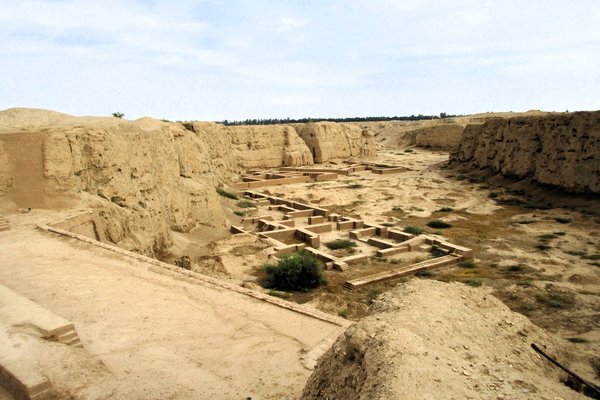Iran
Susa
Susa comprises the remains of an ancient city that is known for its contribution to the development of the early state and urbanization.
One of the oldest-known settlements of the region, dating from as early as 4395 BCE, it became the capital of the Elamite and Achaemenid empires. During the Elamite period, it already showed the beginnings of urban development. 27 layers of superimposed urban settlements have been uncovered. During the Achaemenid period, a new type of ceremonial architecture was developed here at the Royal Palace of Darius and Apadana.
Community Perspective: “Susa is one of those Archaeological sites whose fame and significance outweigh what is actually ‘on show’”. Still, it is worth visiting: Solivagant has detailed a visit of about 2 hours.
Site Info
Official Information
- Full Name
- Susa (ID: 1455)
- Country
- Iran
- Status
-
Inscribed 2015
Site history
History of Susa
- 2015: Inscribed
- Inscribed
- 2014: Postponed
- "In compliance with paragraph 61 of the Operational Guidelines, the examination of this nomination submitted before 2 February 2013 was postponed to 2015"
- Type
- Cultural
- Criteria
- i
- ii
- iii
- iv
Links
- UNESCO
- whc.unesco.org
- Official
-
- visitiran.ir — Visit Iran
All Links
UNESCO.org
- whc.unesco.org — whc.unesco.org/
Official Website
- visitiran.ir — Visit Iran
News Article
- Nov. 24, 2014 en.mehrnews.com — Excavations in the urban environment had destructed part of Susa monuments
Community Information
- Community Category
- Archaeological site: Near Eastern
Travel Information
Red Zone Travel Advisory
Recent Connections
-
Shortest WHS names
4 letters -
Red Zone Travel Advisory
Iran fully off-limits -
Shush Hotspot
Connections of Susa
- Individual People
-
-
Alexander the Great
The "Susa Weddings"See en.wikipedia.org
-
- Trivia
-
-
Former Largest Cities
possibly the largest city around 3500 BC. -
In the British museum
Glazed brick guardsman frieze, taken from a Susa palaceSee www.ancient.eu
-
In the Louvre
Stele representing King Untash Napirisha, "King of Anzan and Susa". This stele with four registers was commissioned by the Elamite king Untash-Napirisha for the city of Chogha Zanbil. It was later moved to Susa by one of his successors, -
Built or owned by French
Shush Castle "located in the ruins of the ancient city of Susa . Constructed by French archaeologist Jean-Marie Jacques de Morgan in the late 1890s, as a secure base for archaeological exploration and excavation. The Castle is similar to medieval monuments in France. The structure was built by local craftsmen with bricks taken from two other archaeological sites, the Achaemenid Darius/Dariush castle and the Elamite Choqazanbil ziggurat. It is built atop a hill ("tappeh") which may contain other relics of past times. It is an example of the pre-scientific era of archaeology, when explorers mutilated or destroyed sites in the process of examining them. The former French government property was taken over by the Islamic Republic after the Iranian Revolution in 1979" . See -See en.wikipedia.org
-
- History
-
-
Akkadian Empire
"Susa was the capital of an Akkadian province until ca. 2100 BC" (wiki), "From the Akkadian period (c.2334 – 2154) to the collapse of the Ur III Dynasty in 2004 BC, a sequence of Mesopotamian kings ruled over Susa" (nom file) -
Located in a Former Capital
Elamite capital -
Mongol Invasions
In 1218, the city was razed by invading Mongols (wiki) -
Silk Roads
(Near) Southern Land Route; in ICOMOS thematic study but no details on role or function. Had its heydays much earlier. -
Specified on Herodotus' Oikumene
-
Parthian Empire
.. it fell under Seleucid and then Parthian spheres of influence. It is assumed Susa became a colony of retired soldiers who settled there and were given land plots to be cultivated. During Parthian rule improvements to the irrigation system contributed to increasing the fertility of the surrounding area. (AB ev) -
Achaemenid Empire
Under the Achaemenids, and particularly from Darius' reign, Susa was one of the elected residences of the Kings. (AB ev) -
Oldest continuously inhabited cities
Susa (now Shush), 4200 BC - however, Susa’s claims are somewhat dented by the fact that it was downgraded to “small settlement” between the 15th and 20th centuries. See
-
- Architecture
- Damaged
-
-
Destroyed during invasion
In 1218, the city was razed by invading Mongols (wiki) -
Damaged in War since WWII
The palace was badly damaged by shelling during the Iran-Iraq war.
-
- World Heritage Process
-
-
Already inscribed still on T List
Shush -
Postponed sites
In 2013 (for nomination in 2014) as 2nd cultural nomination after Sharhr-I Sokhta
-
- Religion and Belief
-
-
Notable mosques
Grand Mosque (presumed to be 7th century CE) were also discovered. The mosque is said to be one of the earliest built in Iran. (AB ev) -
Jewish religion and culture
Esther ScrollSee en.wikipedia.org
-
Mentioned in the Bible
Susa is also mentioned in the Ketuvim of the Hebrew Bible by the name Shushan, mainly in Esther, but also once each in Nehemiah and Daniel. Both Daniel and Nehemiah lived in Susa during the Babylonian captivity of the 6th century BCE. Esther became queen there, and saved the Jews from genocide. A tomb presumed to be that of Daniel is located in the area, known as Shush-Daniel. The tomb is marked by an unusual white stone cone, which is neither regular nor symmetric. Many scholars believe it was at one point a Star of David. Susa is further mentioned in the Book of Jubilees (8:21 & 9:2) as one of the places within the inheritance of Shem and his eldest son Elam; and in 8:1, "Susan" is also named as the son (or daughter, in some translations) of Elam. (wiki)
-
- Human Activity
-
-
Sugar
sugar cane factory (12th century CE) -
Famous Archaeological Trenches
Contains several remaining visible trenches. The most famous is described here - "At the base of his still gargantuan grande tranchée (measuring 100 by 40 metres), de Morgan realised that he had not by any means reached the primordial horizon that he sought" (link). There is also Ghirshman's "Stratigraphic Trench" known as "VR A" which uncovered the "Ville Royale".
-
- Constructions
-
-
Acropolis
The Acropolis contains the most ancient evidence of settlement and was probably the core of Proto-Elamite Susa. (AB ev)
-
- Timeline
-
-
Built in the 5th millennium BC
representing the beginnings of urban development in the proto-Elamite and Elamite periods, from the late fifth millennium BCE (OUV)
-
- WHS Hotspots
- Visiting conditions
-
-
Red Zone Travel Advisory
Iran fully off-limits
-
- WHS Names
-
-
Shortest WHS names
4 letters
-
News
- en.mehrnews.com 11/24/2014
- Excavations in the urban environme…
Recent Visitors
Visitors of Susa
- Afshin Iranpour
- Alexander Barabanov
- Alexander Parsons
- Ammon Watkins
- Ask Gudmundsen
- Atila Ege
- Bernard Joseph Esposo Guerrero
- David Marton
- Erik Jelinek
- Fan Yibo
- fedemarch92
- Harry Mitsidis
- Ivan Rucek
- Jean Lecaillon
- Joyce van Soest
- Ken DJ
- Knut
- Maciej Gil
- Martina Rúčková
- MaYumin
- Miloš Tašković
- Nihal Ege
- Roman Bruehwiler
- Solivagant
- Stanislaw Warwas
- Szucs Tamas
- Taotao Chen
- Thomas Buechler
- Vsacan
- Wojciech Fedoruk
- Zoë Sheng
Community Reviews
Show full reviews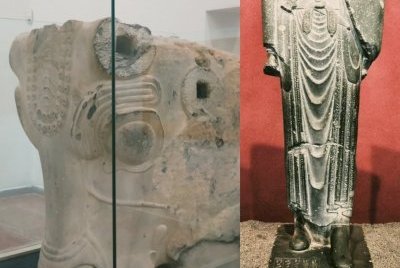
Susa (Shush) isn't exactly the hottest place to stay overnight even if the guest house was just across from the museum and the restaurant around the corner made delicious food. It was getting late so the timing to visit the museum and archeological site was perfect. Surprisingly the place was open on a Friday with her Castle within not open and not on my list to visit anyhow. The staff were also super friendly, trying to sell me some books etc of course, the postcard collection for all WHS in Iran is interesting and some excellent shots but I don't collect these things and we all know they will miss some sites as early as 2019.
The entrance is a little higher than usual because you get the museum at the same time. The museum was quite poor, containing items from other sites unrelated to the archeological site and even total rubbish like antique pistols. The main attraction is the large bull head at the entrance that once posed on a large pillar or something. You get to see a couple more broken pieces in the field. So making my way over there I quickly realized there isn't going to be much to see but low wall outlines where a large palace used to stand. The Apadana Castle must have been grand at one point but now it overgrown with weeds. The path extends far to a lookout where some locals were picnicking even before sunset. You get a …
Keep reading 0 comments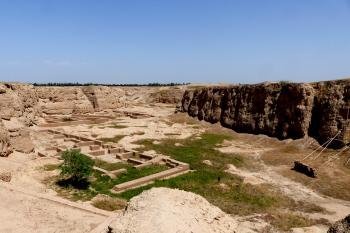
Susa is one of those Archaeological sites whose fame and significance outweigh what is actually “on show”. It was, as Wiki says, “an ancient city of the Proto-Elamite, Elamite, First Persian Empire (ie Achaemenid), Seleucid, and Parthian empires of Iran, and one of the most important cities of the Ancient Near East.” The normal visitor however is going to concentrate on the Elamite and Achaemenid remains - plus a number of aspects relating to its 20th C role in the history of Archaeology!
During our “3 WHS” afternoon (Susa, Chogha and Shushtar) we gave it just under 2 hours. You will face the usual Iranian “multiple ticket” aspect – in this case 150k IR for the site (c US$4), 100k for the museum and another 100k for the “Fort”. We didn’t bother with the nearby separate location of “Ardeshir’s Palace” – the ruins of a structure built by Ataxerxes II to serve his needs whilst he was having the Adapana repaired after it had been destroyed in a fire, it contains the scant remains of a large columned hall but, from the underwhelming photos in the Nomination file, we decided to skip it in favour of more time at the main site.
We started and finished with the Museum which is situated at the main entrance. Some of its articles are copies of originals taken from Susa and now in the Louvre e.g various glazed panels such as the Winged Bull, but there are enough original items on show to …
Keep reading 0 comments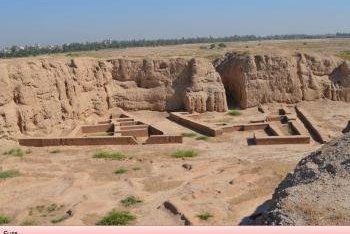
Susa is not as spectacular as Persepolis but still has a lot to offer for tourists and archaeologists. The city is easy to reach from everywhere in western Iran and can be combined with a trip to Chogha Zabil and Shushtar. Being there, do be in a hurry, just let your imagination recreate the pre-Iranic civilizations of Elam.
Keep reading 0 comments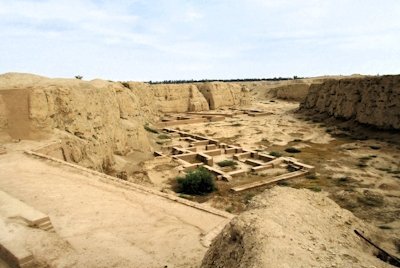
Susa had been one of the most important cities of our world for thousands of years, and its a big shame that it is so ignored in our time. It is without any doubt one of the wonders of the world, and a great heritage from human's past, and in our modern world, and the age of communication, it is being ignored. Yes, I have visited this site, it is amazing, and there is still so much history left there to uncover. As an Iranian and a member of global village I look forward that this site is introduced to the world by UNESCO as world heritage site...
Keep reading 0 comments
